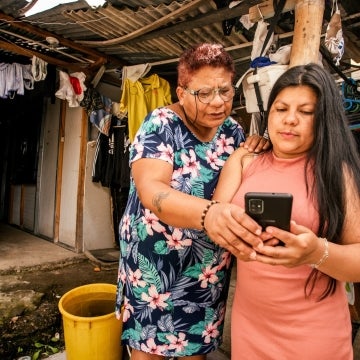The Financial Action Task Force’s (FATF) revised Recommendation 16 (R.16 or ‘Travel Rule’) introduces new requirements to improve transparency in payment and value transfers. While these updates aim to combat money laundering, financing of terrorism, and fraud, they also raise important questions about how implementation will affect financial inclusion.
Throughout the revision process, the World Bank and CGAP expressed strong concerns about specific elements of the proposed changes and emphasized the need to ensure that the changes align with financial inclusion goals and maintain a level playing field between different payment methods for goods and services.
Identification and verification
An estimated 4 billion people globally do not have a structured address. Some 850 million do not have access to a formal ID. Some of the earlier proposals for enhanced originator and beneficiary data could have risked creating access barriers for individuals who could not provide or verify the relevant information. The final text that was adopted represents a more pragmatic approach with flexibility for situations where full information on date of birth or full address is not available.
However, concerns remain even with this more pragmatic approach, particularly around the verification of names, addresses, and date of birth information. FATF has indicated that these issues will be addressed in the upcoming (non-binding) guidance, including how to handle missing or partial information in a way that prevents exclusionary practices. While this will certainly be a helpful step, it is essential that the flexibility within the new rules is meaningfully implemented by the private sector. Guidance alone may not be sufficient to prevent institutions from denying services to users who are unable to verify their information.
Implementation of the de minimis threshold
In principle, the de minimis threshold can play an important role in ensuring that simplified data requirements for lower-value payments support financial inclusion. The threshold of USD/EUR 1,000 for qualifying cross-border payments and value transfers is intended to avoid creating an undue burden on remittances, which many vulnerable populations depend on. However, the adoption of the threshold is optional, and R.16 explicitly requires countries to minimize thresholds where they are adopted (Interpretative Note to R.16(2)). Different countries, therefore, apply different thresholds, which undermines the objective of exempting remittances and hinders efforts to establish a harmonized approach across countries. Case in point, the public consultation responses made clear that the de minimis threshold is not working in practice. Faced with a complex, fragmented global regulatory landscape, many institutions choose to require full (non-simplified) data for all transactions and choose not to implement the threshold at all. This problem, while acknowledged during the discussions, was relegated to non-binding guidance.
Cross-border card-based cash withdrawals
The new information requirements that apply to cross-border card-based cash withdrawals will require substantial infrastructure investments that allow for transmitting the cardholder’s name upon request by the acquiring financial institution. Financial institutions are likely to pass the costs onto end-customers, and there is a risk that card issuers may simply turn off this capability to card products aimed at low-income segments. This could particularly affect customers living in border regions who will find it more difficult to access cash safely when they cross the border.
Instant payments for goods and services
While R.16 imposes simpler information requirements on card-based payments for services and goods, it applies the standard requirements for instant payments (or “fast payments”) for these goods and services.
In many low and middle-income countries today, instant payments are already widely used for purchasing goods and services. In India, for example, instant payments account for 60% of the transactions in India’s Unified Payments Interface (UPI) system. As this technology continues to evolve, instant payments are likely to become even more widespread and integral to everyday financial transactions in many regions across the world. They hold significant potential to innovate the payments landscape, particularly for customers in countries with developing economies. The Financial Stability Board (FSB) has recognized the vast potential in connecting providers in different countries to achieve the objectives in the G20/FSB roadmap.
The new R.16 introduces more onerous obligations for instant payments used to purchase goods and services, compared to those applied to card-based payments. This risks stifling innovation. Treating these payment types differently not only creates the risk of market distortion but also gives rise to competition concerns. In practice, there is a growing convergence between card and instant payments – with new hybrid products that share card credentials and instant payment features making it impractical to distinguish the application of R.16 rules based on technology.
In an explanatory note published alongside the revised R.16, the FATF highlighted the fast pace of evolution in the payment sector and the feedback received on the increasingly important role of instant payments. The note includes a commitment “as a priority” to conduct further work on “the risks and controls applicable to different payment mechanisms for goods or services, in order to more closely align the requirements of Recommendation 16 applicable to purchases of goods or services using different payment mechanisms, including instant payments.”
Links to the FATF’s recent work on financial inclusion and next steps
At the June plenary, the FATF also adopted revised financial inclusion guidance. This guidance builds on the February 2025 revision of Recommendation 1 (R.1), requiring countries to identify lower risks and allow and encourage simplified due diligence in such cases. The new guidance explicitly recognizes financial inclusion as a means to mitigate money laundering and terrorism financing risks related to financial exclusion from an overly conservative implementation of the FATF standards. Vulnerable users, on the other hand, benefit from safe and transparent payment and value transfers.
These considerations also informed R.16 discussions, part of which happened in parallel to the changes to R.1 and the work on the financial inclusion guidance.
During the discussions in the FATF working group and at FATF’s Private Sector Collaborative Forum in March 2025 in Mumbai, it was clear that public and private sector views diverge significantly on the risks and on the availability and effectiveness of risk control measures for different payment mechanisms. Ultimately, the FATF functions on consensus, and even a relatively small number of members can prevent the adoption of changes to its standards.
While FATF guidance is non-binding, it helps countries contextualize the Standards, deepen their understanding of risks, and develop appropriate risk-based responses.
The process that now follows provides important opportunities for the financial inclusion community to engage, both by responding to consultations on the forthcoming guidance and working with national authorities involved in the process. Sharing evidence and concrete examples that promote good practices or highlight negative impacts on financial inclusion can help inform the development of the process to ensure that increased safety and transparency do not come at the expense of vulnerable users but instead improve the quality and accessibility of the services they depend on.


